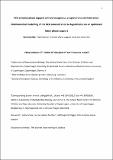Files in this item
Micro-dose hCG as luteal phase support without exogenous progesterone administration : mathematical modelling of the hCG concentration in circulation and initial clinical experience
Item metadata
| dc.contributor.author | Andersen, C Yding | |
| dc.contributor.author | Fischer, R | |
| dc.contributor.author | Giorgione, V | |
| dc.contributor.author | Kelsey, Thomas W | |
| dc.date.accessioned | 2017-07-22T23:33:58Z | |
| dc.date.available | 2017-07-22T23:33:58Z | |
| dc.date.issued | 2016-10 | |
| dc.identifier | 243605680 | |
| dc.identifier | 36daebd2-8660-4de4-8e2c-6d5fd02400a8 | |
| dc.identifier | 27448021 | |
| dc.identifier | 27448021 | |
| dc.identifier | 84979587870 | |
| dc.identifier | 000386373200008 | |
| dc.identifier.citation | Andersen , C Y , Fischer , R , Giorgione , V & Kelsey , T W 2016 , ' Micro-dose hCG as luteal phase support without exogenous progesterone administration : mathematical modelling of the hCG concentration in circulation and initial clinical experience ' , Journal of Assisted Reproduction and Genetics , vol. 33 , no. 10 , pp. 1311-1318 . https://doi.org/10.1007/s10815-016-0764-7 | en |
| dc.identifier.issn | 1058-0468 | |
| dc.identifier.other | ORCID: /0000-0002-8091-1458/work/27201526 | |
| dc.identifier.uri | https://hdl.handle.net/10023/11267 | |
| dc.description | The University Hospital of Copenhagen and the EU interregional project ReproHigh/ReproUnion are gratefully acknowledged for financial support. | en |
| dc.description.abstract | For the last two decades, exogenous progesterone administration has been used as luteal phase support (LPS) in connection with controlled ovarian stimulation combined with use of the human chorionic gonadotropin (hCG) trigger for the final maturation of follicles. The introduction of the GnRHa trigger to induce ovulation showed that exogenous progesterone administration without hCG supplementation was insufficient to obtain satisfactory pregnancy rates. This has prompted development of alternative strategies for LPS. Augmenting the local endogenous production of progesterone by the multiple corpora lutea has been one focus with emphasis on one hand to avoid development of ovarian hyper-stimulation syndrome and, on the other hand, to provide adequate levels of progesterone to sustain implantation. The present study evaluates the use of micro-dose hCG for LPS support and examines the potential advances and disadvantages. Based on the pharmacokinetic characteristics of hCG, the mathematical modelling of the concentration profiles of hCG during the luteal phase has been evaluated in connection with several different approaches for hCG administration as LPS. It is suggested that the currently employed LPS provided in connection with the GnRHa trigger (i.e. 1.500 IU) is too strong, and that daily micro-dose hCG administration is likely to provide an optimised LPS with the current available drugs. Initial clinical results with the micro-dose hCG approach are presented. | |
| dc.format.extent | 8 | |
| dc.format.extent | 874010 | |
| dc.language.iso | eng | |
| dc.relation.ispartof | Journal of Assisted Reproduction and Genetics | en |
| dc.subject | Luteal phase support | en |
| dc.subject | Corpus luteum function | en |
| dc.subject | GnRH agonist trigger | en |
| dc.subject | hCG | en |
| dc.subject | QA75 Electronic computers. Computer science | en |
| dc.subject | QH426 Genetics | en |
| dc.subject | RG Gynecology and obstetrics | en |
| dc.subject | Obstetrics and Gynaecology | en |
| dc.subject | Reproductive Medicine | en |
| dc.subject | Developmental Biology | en |
| dc.subject | Genetics | en |
| dc.subject | Genetics(clinical) | en |
| dc.subject | NDAS | en |
| dc.subject.lcc | QA75 | en |
| dc.subject.lcc | QH426 | en |
| dc.subject.lcc | RG | en |
| dc.title | Micro-dose hCG as luteal phase support without exogenous progesterone administration : mathematical modelling of the hCG concentration in circulation and initial clinical experience | en |
| dc.type | Journal article | en |
| dc.contributor.institution | University of St Andrews. School of Computer Science | en |
| dc.contributor.institution | University of St Andrews. Centre for Interdisciplinary Research in Computational Algebra | en |
| dc.identifier.doi | 10.1007/s10815-016-0764-7 | |
| dc.description.status | Peer reviewed | en |
| dc.date.embargoedUntil | 2017-07-22 |
This item appears in the following Collection(s)
Items in the St Andrews Research Repository are protected by copyright, with all rights reserved, unless otherwise indicated.

